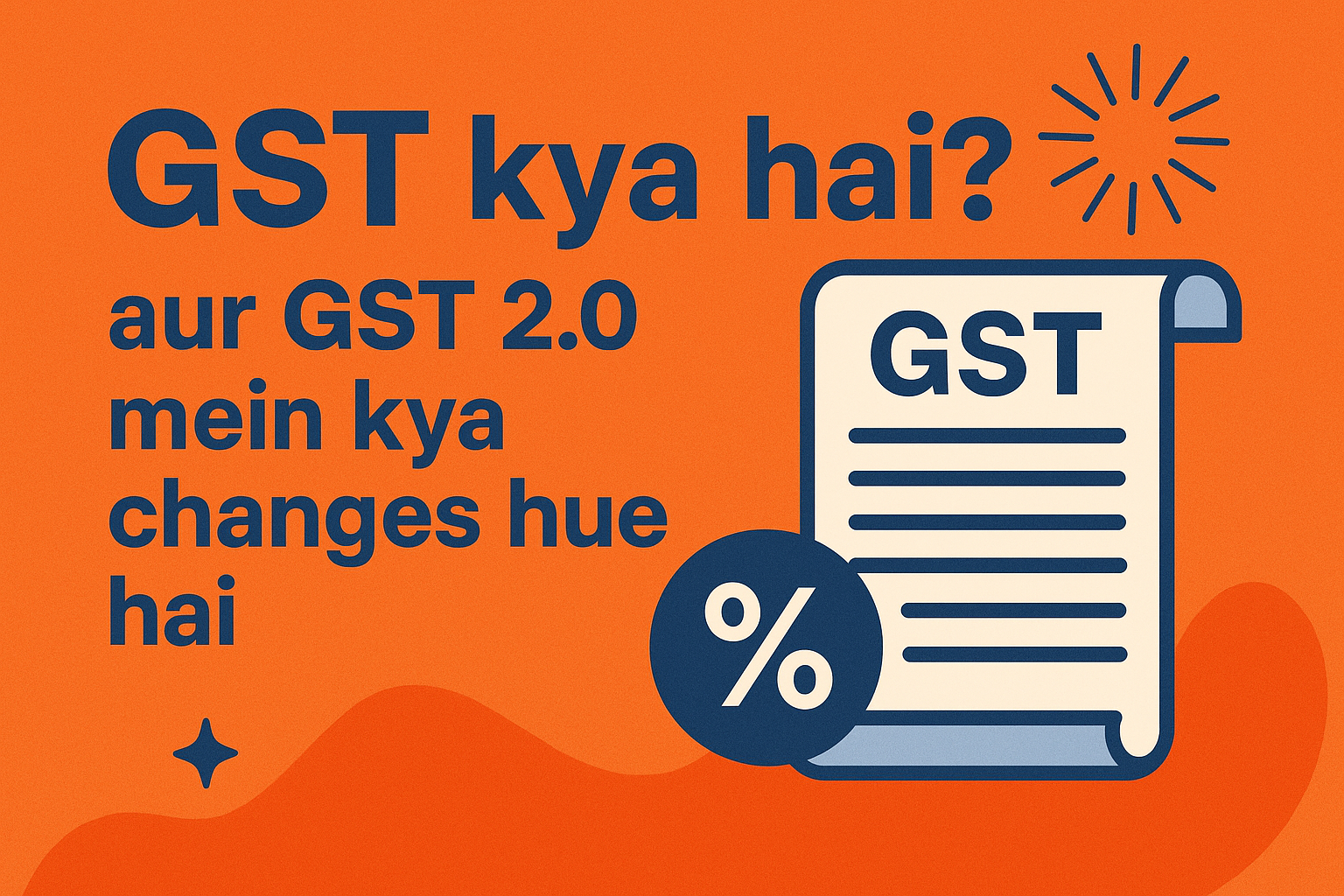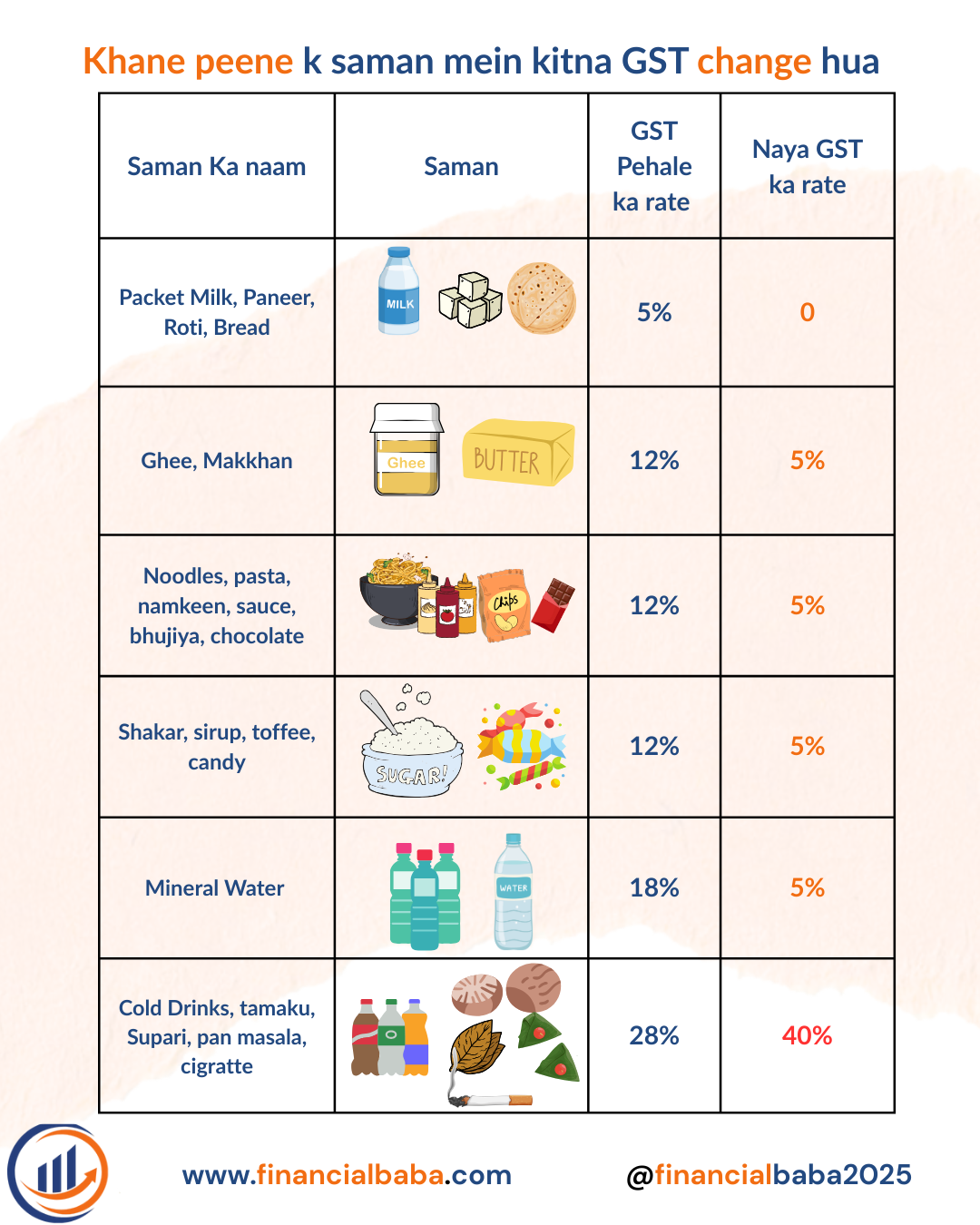Introduction
Aaj ke time mein India ki economy mein Goods and Services Tax ek bahut important role play karta hai. Lekin aksar log ke dimaag mein yeh sawaal hota hai – GST kya hai? India mein GST kab shuru hua? Isko kaise calculate karte hain? Aur GST ko shuru karna zaroori kyun tha?
Is blog mein hum inhi sawalon ke jawab simple aur easy Hinglish mein samajhne ki koshish karenge.
Table of Contents
GST Kya Hai?
Iska full form hai Goods and Services Tax. Ye ek indirect tax hai jo 1 July 2017 ko India mein implement hua.
Isse pehle India mein multiple taxes hote the jaise ki – VAT, Service Tax, Excise Duty, Luxury Tax, etc. Har ek alag department ke under aata tha aur ek product ya service par multiple taxes lagte the.
Isse pehle India mein multiple indirect taxes hote the jaise:
- VAT (Value Added Tax)
- Service Tax
- Excise Duty
- Luxury Tax
Har ek alag department ke under aata tha aur ek product ya service par multiple taxes lagte the.
Goods and Services Tax ne in sab taxes ko replace karke ek single tax system bana diya. Matlab, ab ek hi product ya service par ek single tax lagta hai jo transparent aur simple hai.
GST Kab Shuru Hua India Mein?
India mein Goods and Services Tax ka concept 2000 ke aas-paas introduce hua tha jab ek committee bani thi jiska kaam tha is Tax structure design karna. Lekin isme bahut time laga aur finally 1 July 2017 ko Goods and Services Tax ko officially launch kiya gaya.
| Year | Event |
|---|---|
| 2000 | PM Vajpayee ne ek committee banayi jo Goods and Services Tax law draft kare. |
| 2004 | Task Force ne recommend kiya ki Goods and Services Tax implement karna zaroori hai for better tax system. |
| 2006 | Finance Minister ne propose kiya ki 1 April 2010 se Goods and Services Tax lagu ho. |
| 2007 | CST (Central Sales Tax) ko phase out karne ka decision liya gaya, rate 4% se kam karke 3% hua. |
| 2008 | Empowered Committee (EC) ne dual Goods and Services Tax structure (Central + State levy) finalize kiya. |
| 2010 | Commercial taxes ko computerize karne ka project launch hua, lekin Goods and Services Tax implementation postpone kar diya gaya. |
| 2011 | Constitution Amendment Bill introduce hua Goods and Services Tax law ko enable karne ke liye. |
| 2012 | Standing Committee ne Goods and Services Tax discussion start kiya but Clause 279B par atak gaya. |
| 2013 | Standing Committee ne apni Goods and Services Tax report submit ki. |
| 2014 | Finance Minister ne Goods and Services Tax Bill dobara Parliament mein introduce kiya. |
| 2015 | Lok Sabha ne Goods and Services TaxBill pass kiya, lekin Rajya Sabha mein pass nahi ho saka. |
| 2016 | Amended Model Goods and Services Tax Law dono Houses mein pass hua, President ne assent diya. GSTN (Goods and Services Tax Network) live ho gaya. |
| 2017 | Lok Sabha aur Rajya Sabha ne 4 supplementary Goods and Services Tax Bills pass kiye, Cabinet ne approve kiya. |
| 1 July 2017 | Goods and Services Tax officially India mein launch hua. |
GST Ke Types
India mein Goods and Services Tax ke 4 main types hote hain:
- CGST (Central Goods and Services Tax)
- Ye Central Government ke liye lagta hai.
- Jab goods ya services ek hi state ke andar bikte hain (intrastate supply), toh CGST + SGST dono lagte hain.
- SGST (State Goods and Services Tax)
- Ye State Government ke liye hota hai.
- Intrastate transactions mein CGST ke sath SGST bhi lagta hai.
- Example: Agar Delhi ke andar ek shop se saman kharida gaya, toh CGST + SGST dono lagenge.
- IGST (Integrated Goods and Services Tax)
- Ye tab lagta hai jab goods/services ek state se doosre state mein beche jate hain (interstate supply).
- IGST ko Central Government collect karti hai aur baad mein state ke sath share karti hai.
- UTGST (Union Territory Goods and Services Tax)
- Ye Union Territories (Delhi, Chandigarh, Andaman, Lakshadweep, etc.) mein lagta hai.
- Ye SGST jaisa hi hai lekin UT areas ke liye.
GST Ko Kaise Calculate Karte Hain?
Goods and Services Tax calculation simple hai, bas aapko Goods and Services Tax rate aur product/service ka value pata hona chahiye.
Formula for GST Calculation:
GST Amount = (Original Price × GST Rate) ÷ 100
Net Price = Original Price + GST Amount
Example 1:
Agar aapne ek product kharida jiska price hai ₹1,000 aur uspe 18% GST lagta hai.
- GSTs Amount = (1000 × 18) ÷ 100 = ₹180
- Net Price = 1000 + 180 = ₹1,180
Matlab aapko us product ke liye total ₹1,180 pay karna padega.
Example 2: (Intrastate Transaction)
Ek mobile phone ki base price hai ₹20,000 aur GSTs rate hai 18%.
- GSTs Amount = (20000 × 18) ÷ 100 = ₹3,600
- Final Price = 20,000 + 3,600 = ₹23,600
Ab isme CGST = 9% (₹1,800) aur SGST = 9% (₹1,800) divide hoga.
Example 3: (Interstate Transaction)
Agar wahi phone Delhi se Mumbai becha gaya:
- GSTs Amount = ₹3,600
- Is case mein IGST = 18% (₹3,600) lagta hai.
GST India Mein Kyun Shuru Hua?
Shuru hone ke peeche kai reasons the:
- Multiple Taxes ko Replace Karna – Pehle ek product par alag-alag taxes lagte the jo confusing the. Goods and Services Tax ne is problem ko solve kiya.
- One Nation, One Tax System – Pure India mein ek hi tax system applicable hai, jisse transparency aayi.
- Tax Evasion Control – Goods and Services Tax ke under online system hai jisse black money aur tax evasion kam hua.
- Business Friendly Environment – Small aur medium businesses ke liye compliance simple hua.
- Consumer Benefit – Ab ek product par ek hi tax lagta hai jo pehle ke comparison mein kaafi sasta padta hai.
GST ke Benefits:
- One Nation, One Tax ka dream pura hua.
- Cascading Effect khatam hua (ab ek hi tax lagta hai).
- Digital aur transparent system bana.
- Business aur consumers dono ke liye simple aur fair system bana.
- Exports aur economy growth ko boost mila.
GST Rates India Mein (2017 se)
Taxes alag-alag goods aur services par different rates mein lagta hai:
| Goods and Services Tax Slab | Goods/Services Example |
|---|---|
| 0% | Fresh vegetables, milk, wheat, rice |
| 5% | Essential items (sugar, tea, medicines) |
| 12% | Processed food, computers |
| 18% | Mobile phones, restaurants, industrial products |
| 28% | Luxury items (cars, AC, tobacco, perfumes) |
Naya Goods and Services Tax Reform 2025: Ab Aapki Jeeb Mein Kitne Rupaye Bachenge?
GST 2.0 Ka Overview
PM Modi ne 15 August 2025 ko diwali gift ka announcement kiya tha: Goods and Services Tax reforms! Council ki 56th meeting mein Finance Minister Nirmala Sitharaman ne ye decide kiya ki ab 4 slab (5%, 12%, 18%, 28%) ko 2 slab (5% aur 18%) mein convert kar diya jayega. Jo 22 September 2025 se lagu hoga
Key Points:
- Daily Essentials: Soap, shampoo, bread, milk, paneer aur dusre common food items ab Goods and Services Tax -free ya low slab mein.
- Luxury Items: Cars, ACs, big TVs ka ab 18% mein.
- High-end Luxury: Ab 40% slab lagega, pehle 28% + cess tha.
Iska main maksad:
- Common man ko relief dena
- MSMEs aur small industries ko support karna
- Harmful products jaise tobacco par tax badhakar unka use kam karna
GST Slab Ka Naya Structure
| Category | Pehle Ka Slab | Naye Slab | Effect |
|---|---|---|---|
| Daily essentials (milk, bread, raita) | 12% | 5% | Sasta |
| AC, Cars, Big TVs | 28% | 18% | Saving ₹1500-3500 |
| Health & Life Insurance | 18% | 0% | Saving ₹1800 per ₹10,000 premium |
| Luxury/High-end items | 28% + Cess | 40% | Slightly Mahanga |
| Mobiles & Laptops | 18% | 18% | No change |
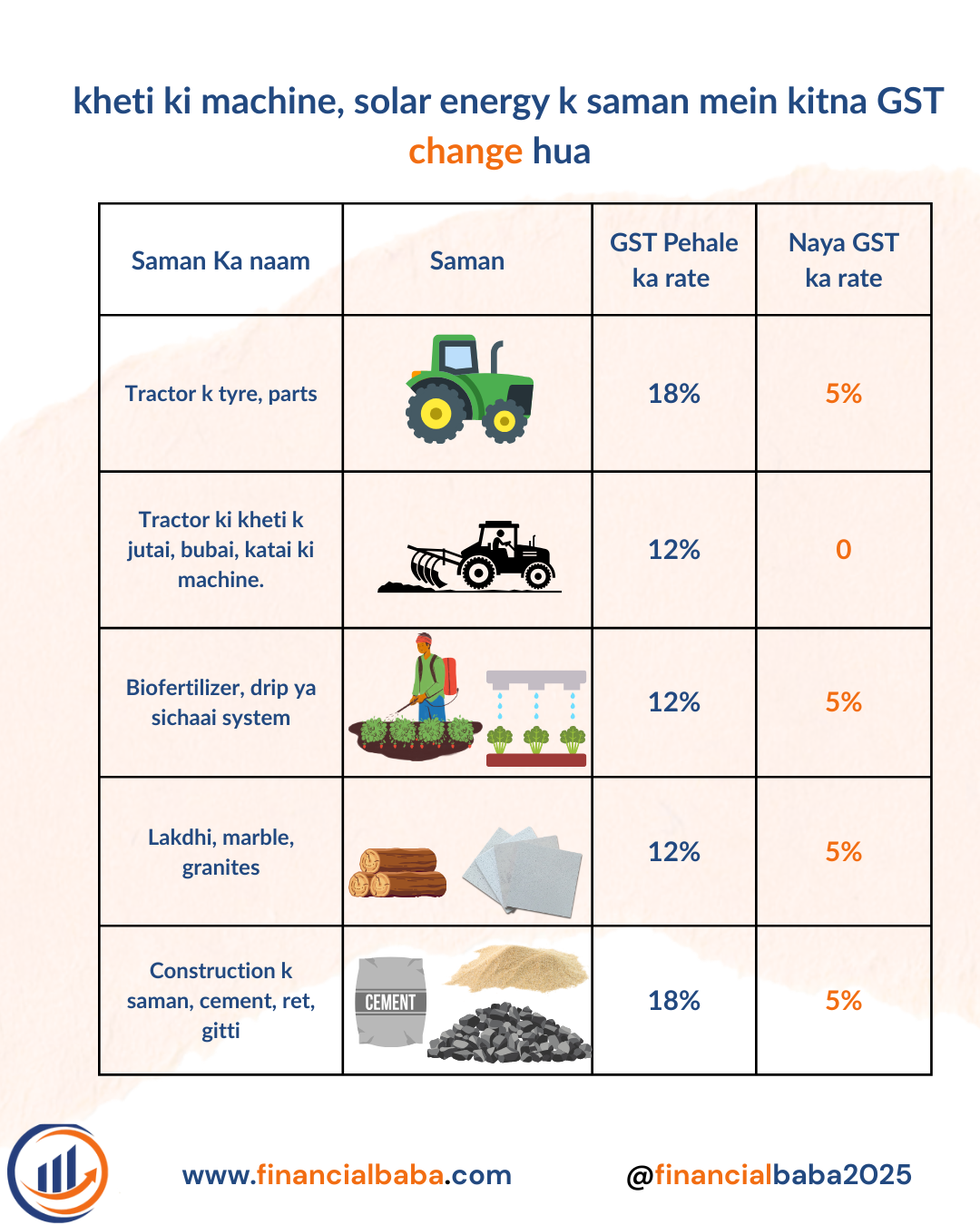
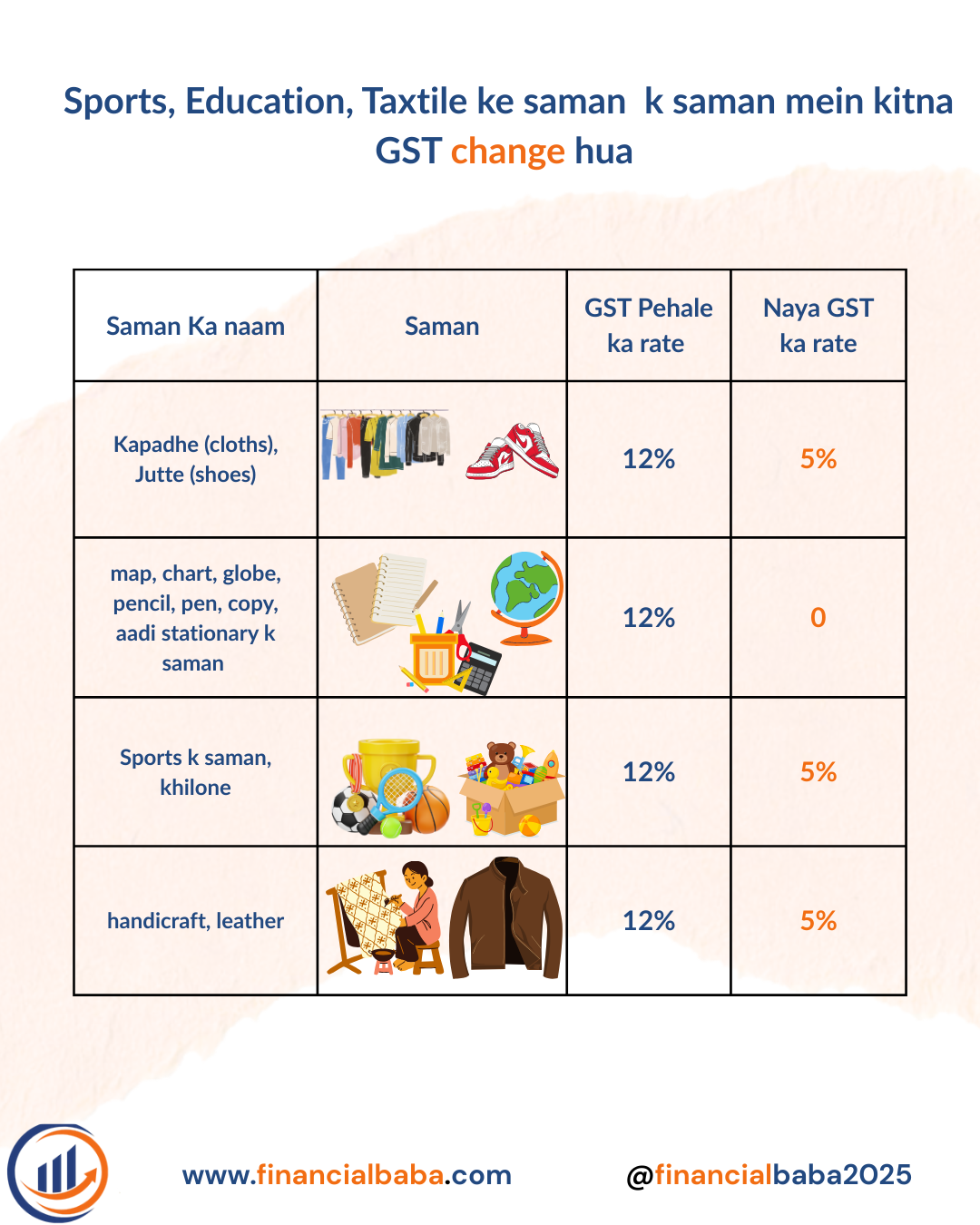
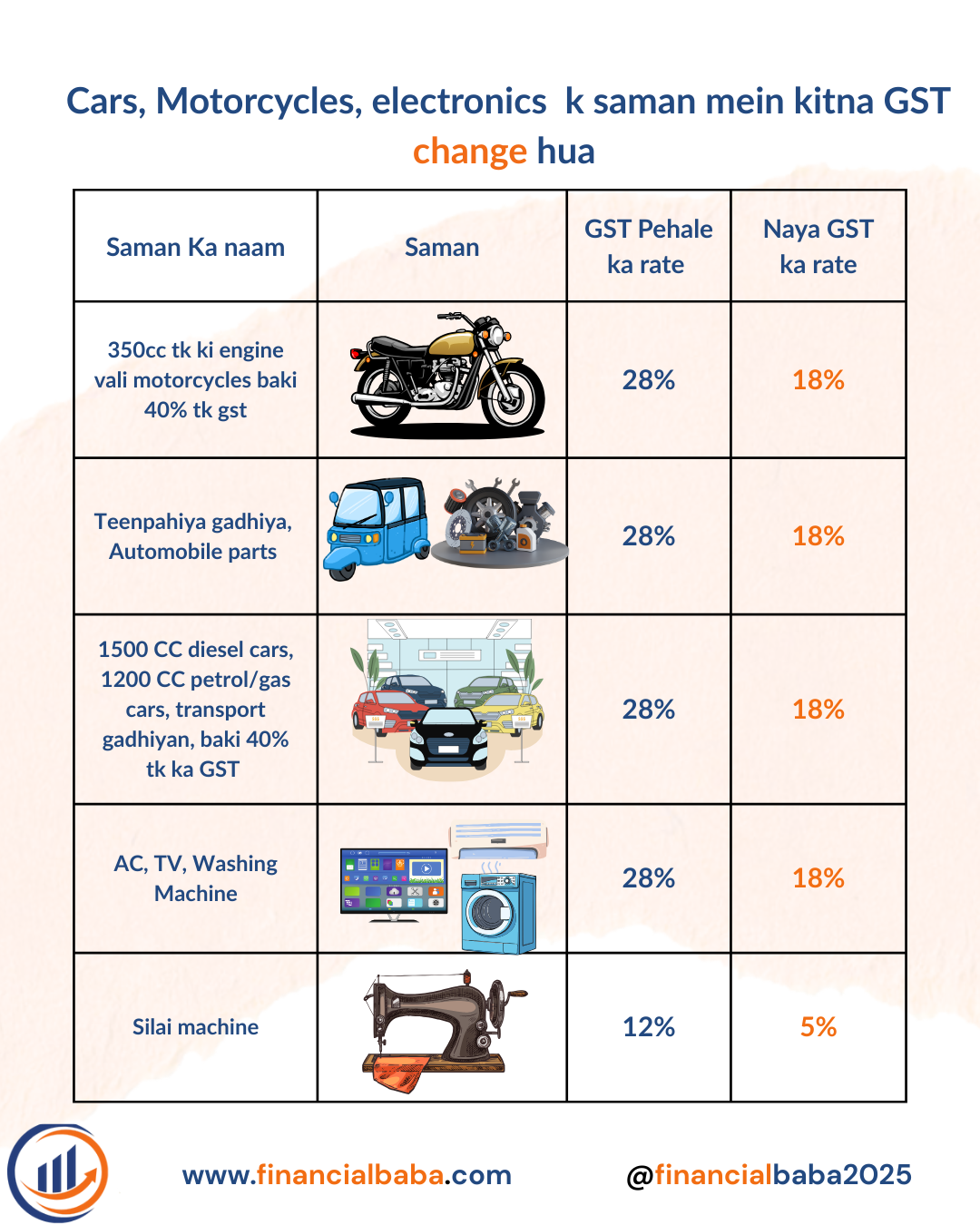
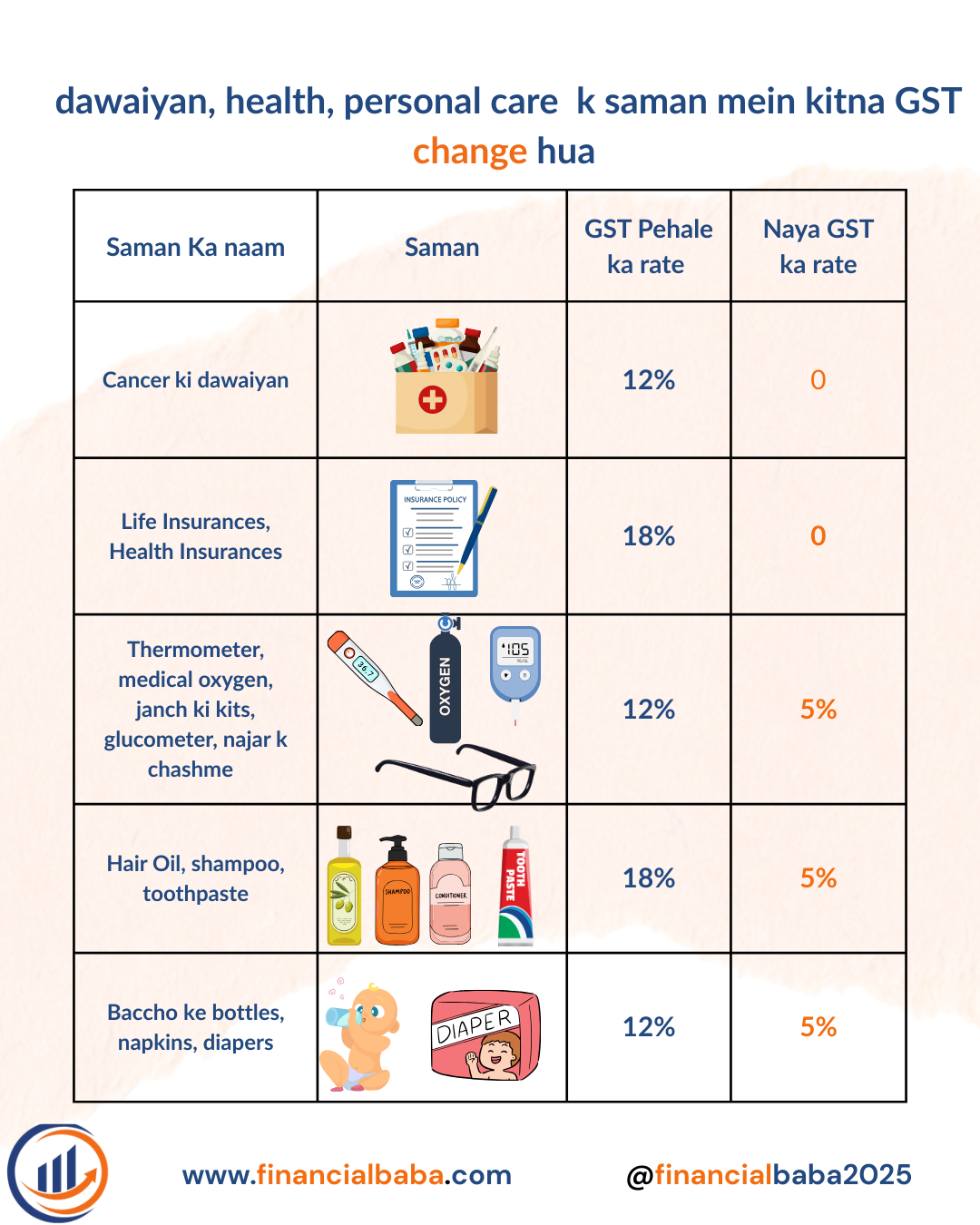
Aapki Jeeb Mein Kitna Bachenge?
Example:
- Grocery: Agar aap ₹20,000 per month grocery par spend karte hain, to ₹1,000 ki saving hogi.
- Insurance: ₹10,000 ka health/term insurance ab ₹1,800 cheaper.
- AC: ₹1,500-2,500 ki direct saving.
- TV (32-inch+): ₹2,500-3,500 bachega.
- Construction: ₹20 lakh ke ghar pe kam hone se ₹50,000 tak bach sakta hai.
- Mobiles/Laptops: No saving, same.
GST Reform Kab Se Lagoo Hoga?
22 September 2025 se Goods and Services Tax ki nayi rates officially implement hongi.
Expert Tip: 4 Sept se 22 Sept tak market mein slight slowdown ho sakta hai, kyunki log diwali tak wait karenge naye Goods and Services Taxslab ke liye.
Kya Kuch Cheeze Mehngi Bhi Hui?
Haan, high-end luxury items ke liye 40% slab banaya gaya hai.
Ye government ke liye revenue compensate karne ka ek tareeka hai. SBI Research ke according, ₹85,000 crore ka annual revenue loss initially ho sakta hai, jo long-term demand growth se cover hoga.
GST Reforms ka Reason: Political & Economic Perspective
- PM Modi ne diwali se pehle ye reform announce kiya tha, taaki common man relief feel kare.
- Tariff pressure (Trump ke 50% tariffs) ke response mein domestic demand boost karna.
- Domestic consumption badhegi, MSMEs aur small traders ko fayda hoga.
- Political angle bhi: Citizens, farmers, small businesses aur youth ko directly benefit milta hai.
GST Slab Reduction ka Export/Trade Impact
- Directly export-import gap pe zyada impact nahi, kyunki mainly Goods and Services Tax domestic tax hai.
- Lekin domestic demand badhne se exporters ko India ke market mein apna maal bechne ka option milega.
- MSMEs ko fayda: Production aur supply chain ko boost milega.
Conclusion
Toh doston, ab aapko clear idea ho gaya hoga ki Goods and Services Tax kya hai, kab start hua, kaise calculate karte hain aur India mein isko shuru karna kyun zaroori tha. Goods and Services Tax ne India ke taxation system ko modernize kiya aur ek transparent, efficient aur simple system create kiya hai.
Naye GST2.0 reforms ka maksad sirf tax simplification nahi, balki common man aur small business ko direct relief dena hai.
Key Takeaways:
- Sirf 2 slabs: 5% aur 18%
- Daily essentials aur insurance me bachat
- Luxury items pe 40% slab
- 22 September 2025 se effective
- Domestic consumption aur MSMEs ko boost
Ye reforms aapke liye real savings aur easier taxation system la rahe hain.
Aaj ke time mein chahe aap businessman ho ya consumer, Goods and Services Tax ke baare mein knowledge hona bahut zaroori hai.
Aur Investing ya share Market
Frequently Asked Questions (FAQs)
Q1.जीएसटी का मतलब क्या है?
Ans. GST ka matlab hai – Goods and Services Tax (वस्तु एवं सेवा कर)।
ये ek indirect tax hai jo goods aur services dono par lagta hai.
GST ne pehle ke multiple indirect taxes (jaise VAT, Excise Duty, Service Tax, Entry Tax) ko replace karke ek single unified tax system bana diya.
Simple words mein:
G = Goods (सामान)
S = Services (सेवाएँ)
T = Tax (कर)
👉 Matlab, jab aap koi cheez kharidte ho (jaise mobile, laptop, car) ya service lete ho (jaise restaurant, cab, hotel booking) toh uspe ek hi tax lagta hai.
Q2. जीएसटी के 4 प्रकार क्या हैं?
Ans. जीएसटी k 4 types hote aur bki k jaankari k liye yha link press kare
Agar aapne Delhi ke andar mobile kharida → CGST + SGST
Agar aapne Delhi se Mumbai mobile kharida → IGST
Agar aapne Andaman se kharida → CGST + UTGST
Q3.40% जीएसटी क्या है?
Ans.
India mein officially ki highest slab 28% hai.
Matlab abhi tak 40% ka koi fixed GST slab nahi hai.
Lekin kuch cases mein confusion hota hai jaha GST + Cess mila kar total tax rate 40% ya uske aas-paas ho jata hai.
Example – Luxury Cars aur Tobacco Products 🚗🚬
Luxury cars par GST = 28% + Cess = up to 22%
Total tax = 50% tak pahunch sakta hai.
Cigarettes, pan masala, tobacco par bhi 28% GST ke saath alag-alag cess lagta hai.
Inka effective tax 40% ya usse zyada hota hai.
40% GST ek direct slab nahi hai.
Ye usually tab hota hai jab 28% GST + additional Cess add hota hai on luxury & sin goods.
Q4.जीएसटी का नियम 3 क्या है?
Ans.
Rule 3 basically batata hai “Composition Scheme ko kaise choose karein.”
Is scheme mein small taxpayers ko kam tax rate dena padta hai aur unki compliance bhi easy hoti hai (monthly return ke jagah quarterly return).
Example
Agar ek trader ka annual turnover ₹1.5 crore se kam hai (₹75 lakh kuch states mein), toh wo Composition Scheme le sakta hai:
Manufacturers/traders par 1%
Restaurants par 5%
Service providers par 6%
Q5.क्या मैं बिना सीए के खुद जीएसटी फाइल कर सकता हूं?
Ans .
Haan, aap bina CA (Chartered Accountant) ke khud apna GST file kar sakte ho.
filing ka pura process online portal (www.gst.gov.in) par hota hai, jo user-friendly hai.
Kaise khud GST file karein?
1. Portal pe login karein – www.gst.gov.in
2.Username & password se apna dashboard open karein.
3.Return Filing Section choose karein (jaise GSTR-1, GSTR-3B, etc.)
4.Sales aur Purchase invoices ka data upload karein (monthly/quarterly as per scheme).
5.Tax liability calculate hogi (portal automatically show karta hai).
6.Payment online karein (Netbanking, UPI, NEFT/RTGS).
7.Return submit karein aur ARN (Acknowledgement Number) save kar lein.
Lekin Dhyaan Rahe
Agar aapke invoices jyada hain aur turnover high hai, toh CA ki help lena safe hota hai, kyunki galti hone par penalty aur late fees lag sakti hai.
Small businesses ya composition scheme wale log easily khud file kar sakte hain.

